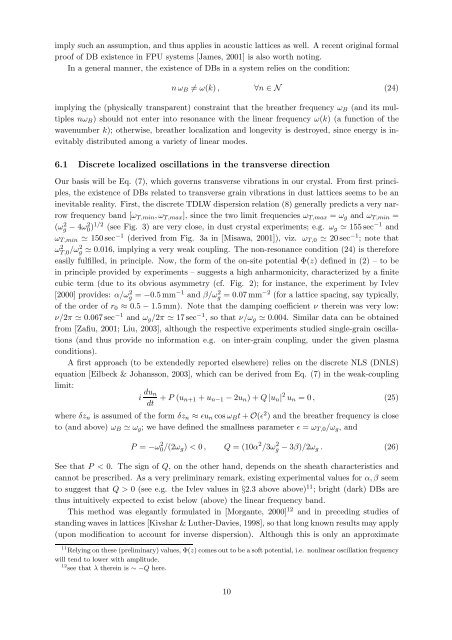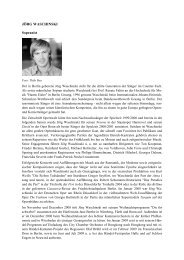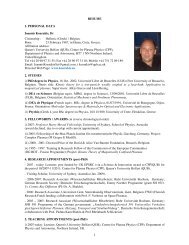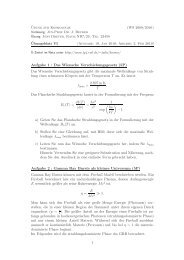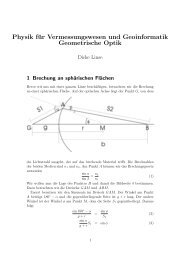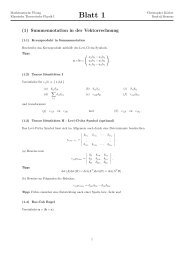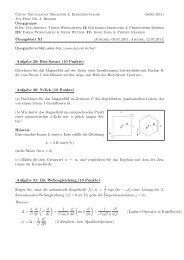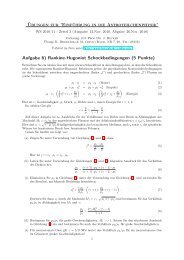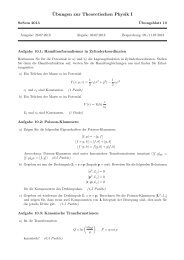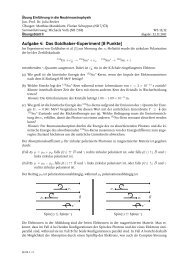View - Theoretische Physik IV - Ruhr-Universität Bochum
View - Theoretische Physik IV - Ruhr-Universität Bochum
View - Theoretische Physik IV - Ruhr-Universität Bochum
Create successful ePaper yourself
Turn your PDF publications into a flip-book with our unique Google optimized e-Paper software.
imply such an assumption, and thus applies in acoustic lattices as well. A recent original formal<br />
proof of DB existence in FPU systems [James, 2001] is also worth noting.<br />
In a general manner, the existence of DBs in a system relies on the condition:<br />
n ω B ≠ ω(k), ∀n ∈ N (24)<br />
implying the (physically transparent) constraint that the breather frequency ω B (and its multiples<br />
nω B ) should not enter into resonance with the linear frequency ω(k) (a function of the<br />
wavenumber k); otherwise, breather localization and longevity is destroyed, since energy is inevitably<br />
distributed among a variety of linear modes.<br />
6.1 Discrete localized oscillations in the transverse direction<br />
Our basis will be Eq. (7), which governs transverse vibrations in our crystal. From first principles,<br />
the existence of DBs related to transverse grain vibrations in dust lattices seems to be an<br />
inevitable reality. First, the discrete TDLW dispersion relation (8) generally predicts a very narrow<br />
frequency band [ω T,min ,ω T,max ], since the two limit frequencies ω T,max = ω g and ω T,min =<br />
(ωg 2 − 4ω0 2)1/2 (see Fig. 3) are very close, in dust crystal experiments; e.g. ω g ≃ 155sec −1 and<br />
ω T,min ≃ 150sec −1 (derived from Fig. 3a in [Misawa, 2001]), viz. ω T,0 ≃ 20sec −1 ; note that<br />
ωT,0 2 /ω2 g ≃ 0.016, implying a very weak coupling. The non-resonance condition (24) is therefore<br />
easily fulfilled, in principle. Now, the form of the on-site potential Φ(z) defined in (2) – to be<br />
in principle provided by experiments – suggests a high anharmonicity, characterized by a finite<br />
cubic term (due to its obvious asymmetry (cf. Fig. 2); for instance, the experiment by Ivlev<br />
[2000] provides: α/ωg 2 = −0.5mm−1 and β/ωg 2 = 0.07mm−2 (for a lattice spacing, say typically,<br />
of the order of r 0 ≈ 0.5 − 1.5mm). Note that the damping coefficient ν therein was very low:<br />
ν/2π ≃ 0.067sec −1 and ω g /2π ≃ 17sec −1 , so that ν/ω g ≃ 0.004. Similar data can be obtained<br />
from [Zafiu, 2001; Liu, 2003], although the respective experiments studied single-grain oscillations<br />
(and thus provide no information e.g. on inter-grain coupling, under the given plasma<br />
conditions).<br />
A first approach (to be extendedly reported elsewhere) relies on the discrete NLS (DNLS)<br />
equation [Eilbeck & Johansson, 2003], which can be derived from Eq. (7) in the weak-coupling<br />
limit:<br />
i du n<br />
dt + P (u n+1 + u n−1 − 2u n ) + Q |u n | 2 u n = 0, (25)<br />
where δz n is assumed of the form δz n ≈ ɛu n cos ω B t + O(ɛ 2 ) and the breather frequency is close<br />
to (and above) ω B ≃ ω g ; we have defined the smallness parameter ɛ = ω T,0 /ω g , and<br />
P = −ω 2 0/(2ω g ) < 0, Q = (10α 2 /3ω 2 g − 3β)/2ω g . (26)<br />
See that P < 0. The sign of Q, on the other hand, depends on the sheath characteristics and<br />
cannot be prescribed. As a very preliminary remark, existing experimental values for α,β seem<br />
to suggest that Q > 0 (see e.g. the Ivlev values in §2.3 above above) 11 ; bright (dark) DBs are<br />
thus intuitively expected to exist below (above) the linear frequency band.<br />
This method was elegantly formulated in [Morgante, 2000] 12 and in preceding studies of<br />
standing waves in lattices [Kivshar & Luther-Davies, 1998], so that long known results may apply<br />
(upon modification to account for inverse dispersion). Although this is only an approximate<br />
11 Relying on these (preliminary) values, Φ(z) comes out to be a soft potential, i.e. nonlinear oscillation frequency<br />
will tend to lower with amplitude.<br />
12 see that λ therein is ∼ −Q here.<br />
10


